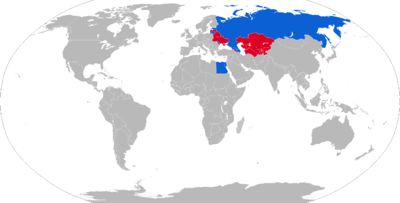2B11
| 2B11 | |
|---|---|
|
Lithuanian Army operating a 2B11 | |
| Type | Mortar |
| Place of origin | Soviet Union |
| Service history | |
| In service | 1981 – present |
| Production history | |
| Designed | 1981 |
| Manufacturer | Motovilikhinskiye Zavody Special Engineering and Metallurgy JSC |
| Specifications | |
| Weight | 210 kg (460 lb) |
| Crew | 5 |
|
| |
| Shell | HE, smoke, illuminating and incendiary |
| Caliber | 120 mm (4.7 in) |
| Carriage | 2F510 2x1 wheeled transport chassis, GAZ-66 4×4 truck (prime mover) |
| Elevation | 45°–80° |
| Traverse | ±5° (without bipod repositioning) |
| Rate of fire | 15 rounds per minute |
| Effective firing range |
Minimum: 0.46 km (0.29 mi) Maximum: 7.18 km (4.46 mi) |
| Sights | MPM-44M |
The 2B11 is a 120 mm mortar developed by the Soviet Union in 1981 and subsequently fielded in the Soviet Army. The basic design for the 2B11 was taken from the classic Model 1943 120 mm mortar, and incorporated changes to make the mortar less heavy.[1] Is a part 2S12 Sani.
The 2B11 has proliferated to other countries primarily as result of the collapse of the Soviet Union.
The 2B11 and comparable mortars
| Equipment | Weight | Elevation | Traverse | Rate of fire | Range | Projectile | Proj weight | Explosive weight[2] | Comments |
|---|---|---|---|---|---|---|---|---|---|
| |
210 kg | 45–80° | 5° | 12–15 rpm | 460–7,180 meters | 120 mm HE unspecified | 16.8 kg | ? | New type of projectile, weight include carriage |
| |
145 kg | 45–85° | 14° | 16 rpm | 300–7,240 meters | 120 mm M933 | 13.65 kg | 2.99 kg | — |
| |
582 kg | 30–85° | 14° | 18 rpm | 1,100–13,000 meters | 120 mm PRPA | 18.6 kg | 2.7 kg | Rocket-assisted projectile Regular projectile has ~8 km range |
Operators

Map with 2B11 operators in blue and former operators in red
Current operators
Former operators
Notes
- ↑ www.janes.com
- ↑ Per Jane's Infantry Weapons 2007-2008
- ↑ "Armament of the Georgian army". Georgian Army. Retrieved 2007-06-25.
See also
- Cardom 120 mm recoil mortar system
- Soltam K6 120 mm mortar
- Soltam M-65 120 mm mortar
- 120 KRH 92 120 mm mortar
- 120mm M2 RAIADO 120 mm mortar
- 2S12 Sani 120 mm mortar
- Mortier 120mm Rayé Tracté Modèle F1 120 mm mortar
External links
This article is issued from Wikipedia - version of the 9/10/2016. The text is available under the Creative Commons Attribution/Share Alike but additional terms may apply for the media files.
